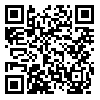Thu, Nov 14, 2024
[Archive]
Volume 18, Issue 4 (December 2021)
IJMSE 2021, 18(4): 1-14 |
Back to browse issues page
Download citation:
BibTeX | RIS | EndNote | Medlars | ProCite | Reference Manager | RefWorks
Send citation to:



BibTeX | RIS | EndNote | Medlars | ProCite | Reference Manager | RefWorks
Send citation to:
Golbabaie F, Farhang Dehghan S, Habibi Mohraz M, Akhlaghi Pirposhteh E. Role of the Electrostatic Mechanism in the Filtration Process of Nanofibers. IJMSE 2021; 18 (4) :1-14
URL: http://ijmse.iust.ac.ir/article-1-2291-en.html
URL: http://ijmse.iust.ac.ir/article-1-2291-en.html
Abstract: (7647 Views)
The present study aims to investigate the role of the electrostatic mechanism in the filtration process of Polyacrylonitrile nanofibers containing single-walled carbon nanotube. The nanofibers were fabricated via electrospinning using 16wt% Polyacrylonitrile polymer (PAN) solution, single-wall carbon nanotubes (SWNT) at a ratio of 99:1 along with N and N-Dimethylformamide solvents. Initial filtration efficiency was tested as per ISO 29463:2011 standard inside a test rig. An electrostatic discharge test was performed via the chemical treatment of the filter media with Isopropyl alcohol in accordance to EN779 standard. Mean initial filtration efficiency of the nanofiber media in the capturing of 100nm and 200nm particles were 95.92% ±2.74 and 97.26% ±1.11 respectively, while for particles between 80nm to 250nm, this was 96.73% ±2.74. The efficiency of the untreated media was 0.2% to 1.2% higher than the PAN/SWNT media after electron discharge using Isopropyl alcohol with an even bigger difference being observed at lower particle size ranges. After treatment with Isopropyl alcohol, the pressure drop of the filtration media was increased from 164.7 Pa to 185.3 Pa. The reduction in filtration efficiency observed after the electrostatic discharge test indicates that the electrical charge of the electrospun nanofibers is influential in its initial efficiency for removing the submicron particles.
Type of Study: Research Paper |
Subject:
Ceramics
Send email to the article author
| Rights and permissions | |
 |
This work is licensed under a Creative Commons Attribution-NonCommercial 4.0 International License. |






